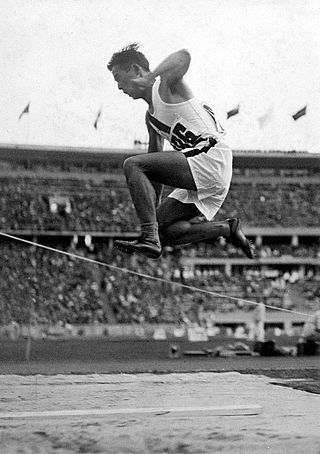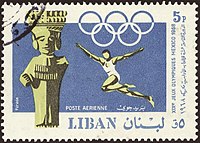
The long jump is a track and field event in which athletes combine speed, strength and agility in an attempt to leap as far as possible from a takeoff point. Along with the triple jump, the two events that measure jumping for distance as a group are referred to as the "horizontal jumps". This event has a history in the ancient Olympic Games and has been a modern Olympic event for men since the first Olympics in 1896 and for women since 1948.

Robert Beamon is an American former track and field athlete, best known for his world record in the long jump at the Mexico City Olympics in 1968. By jumping 8.90 m, he broke the existing record by a margin of 55 cm and his world record stood for almost 23 years until it was broken in 1991 by Mike Powell. The jump is still the Olympic record and the second-longest in history unassisted by wind.

Ralph Harold Boston was an American track athlete who received three Olympic medals and became the first person to break the 27 feet (8.2 m) barrier in the long jump.

The men's long jump was one of four men's jumping events on the Athletics at the 1964 Summer Olympics program in Tokyo. It was held on 18 October 1964. 37 athletes from 23 nations entered, with 5 not starting in the qualification round. The maximum number of athletes per nation had been set at 3 since the 1930 Olympic Congress. The event was won by Lynn Davies of Great Britain, breaking a string of eight straight American victories. It was Great Britain's first gold medal in the men's long jump, and first medal since 1900. It was only the second time the United States had not won the event, with Sweden's William Petersson in 1920 the only non-American to win before Davies. Ralph Boston of the United States and Igor Ter-Ovanesyan of the Soviet Union became the third and fourth men to win a second medal in the long jump.
At the 1968 Summer Olympics in Mexico City, 36 athletics events were contested, 24 for men and 12 for women. There were a total number of 1031 participating athletes from 93 countries.

Igor Aramovich Ter-Ovanesyan is a Soviet and Ukrainian former long jumper and coach. Competing for the Soviet Union, he was a five-time European and two-time Olympic medalist in this event. In 1985, he was awarded the Order of the Badge of Honour.

The men's long jump at the 1988 Summer Olympics in Seoul, South Korea had a start list of 41 competitors from 31 nations, with two qualifying groups before the final (12) took place on Sunday September 25, 1988. The maximum number of athletes per nation had been set at 3 since the 1930 Olympic Congress.
The men's long jump was an athletics event at the 1996 Summer Olympics in Atlanta, Georgia, United States. There were 54 competitors from 41 nations, with one athlete not starting. The maximum number of athletes per nation had been set at 3 since the 1930 Olympic Congress. The event was won by Carl Lewis of the United States, the nation's fourth consecutive and 20th overall gold medal in the men's long jump. Lewis himself had won the four straight victories, becoming the third Olympian to win the same event four times in a row as well as the only man to win four long jump medals. It was the ninth and final Olympic gold of Lewis's career. James Beckford earned Jamaica's first medal in the event. Joe Greene matched his bronze from 1992, becoming the ninth two-medal winner in the event.
These are the official results of the Men's Long Jump event at the 1991 IAAF World Championships in Tokyo, Japan. There were a total number of 43 participating athletes, with two qualifying groups and the final held on Friday August 30, 1991.
The men's long jump was an event at the 1992 Summer Olympics in Barcelona, Spain. There were 50 participating athletes from 37 nations, with two qualifying groups. The maximum number of athletes per nation had been set at 3 since the 1930 Olympic Congress. The event was won by Carl Lewis of the United States, the nation's third consecutive and 19th overall gold medal in the men's long jump. Lewis became the second man to win three medals in the event and the first to win three golds. Mike Powell repeated his silver-medal performance from 1988, becoming the eighth two-medal winner in the event. Joe Greene took bronze, completing the United States' second consecutive and fourth overall medal sweep in the men's long jump.
The men's long jump event at the 2000 Summer Olympics took place on Monday, 25 September, and Thursday, 28 September 2000, in Sydney, Australia. Fifty-three athletes from 38 nations competed. The maximum number of athletes per nation had been set at 3 since the 1930 Olympic Congress. The event was won by Iván Pedroso of Cuba, the nation's first medal and title in the men's long jump; it snapped a four-Games streak of American victories. Jai Taurima took silver, Australia's third silver in the event. Roman Shchurenko earned Ukraine's first medal in the men's long jump with his bronze. It was the first time the United States had competed in the event and not won at least a silver medal; the Americans had previously failed to place in the top two only at the boycotted 1980 Games.

The men's long jump at the 1980 Summer Olympics in Moscow, Russian SFSR, Soviet Union had a start list of 32 competitors from 23 countries, with two qualifying groups before the final (12) took place on Monday July 28, 1980. The maximum number of athletes per nation had been set at 3 since the 1930 Olympic Congress. The top twelve and ties and all those reaching 7.90 metres advanced to the final. The event was won by Lutz Dombrowski of East Germany, the first gold medal in the men's long jump by any German jumper. Frank Paschek made East Germany the only nation other than the United States to have two men on the podium in the same Games in the event. Valeriy Podluzhniy won the Soviet Union's first men's long jump medal since 1964. The American-led boycott ended the United States' three-Games gold medal streak and 18-Games streak of winning at least a silver medal in the event.

The men's long jump event was part of the track and field athletics programme at the 1936 Summer Olympics. The competition was held on August 4, 1936. Forty-three athletes from 27 nations competed. The maximum number of athletes per nation had been set at 3 since the 1930 Olympic Congress. The final was won by American Jesse Owens. It was the United States' fourth consecutive and ninth overall gold medal in the event; it was also Owens's second of four gold medals in the 1936 Games. Luz Long won Germany's first medal in the event with silver; Naoto Tajima put Japan on the podium for the second Games in a row with bronze.

The men's triple jump event was part of the track and field athletics programme at the 1936 Summer Olympics. The competition was held on August 6, 1936. Thirty-one athletes from 19 nations competed. The maximum number of athletes per nation had been set at 3 since the 1930 Olympic Congress. The final was won by Naoto Tajima of Japan with a world-record jump. It was Japan's third consecutive gold medal in the men's triple jump; as of the 2016 Games, it is the last gold medal Japan has won in the event. Masao Harada's silver medal made it the second Games in which Japan put two men on the podium in the event. Jack Metcalfe of Australia earned bronze, Australia's first medal in the event since 1924.

The men's long jump field event at the 1960 Olympic Games took place on September 2. Forty-nine athletes from 34 nations competed. The maximum number of athletes per nation had been set at 3 since the 1930 Olympic Congress. The event was won by Ralph Boston of the United States, the nation's eighth consecutive and 13th overall victory in the men's long jump. Igor Ter-Ovanesyan's bronze was the Soviet Union's first medal in the event.

The men's triple jump event at the 1976 Summer Olympics in Montreal, Quebec, Canada, had an entry list of 25 competitors, with two qualifying groups before the final (12) took place on Friday July 30, 1976. The top twelve and ties, and all those reaching 16.30 metres advanced to the final. The qualification round was held in Thursday July 29, 1976. The maximum number of athletes per nation had been set at 3 since the 1930 Olympic Congress.

The men's long jump event at the 1972 Summer Olympics in Munich was held on 8 & 9 of September. Thirty-six athletes from 25 nations competed. The maximum number of athletes per nation had been set at 3 since the 1930 Olympic Congress. The event was won by Randy Williams of the United States, the nation's second consecutive and 15th overall gold medal in the men's long jump. Hans Baumgartner earned West Germany's first medal in the event.

The men's triple jump event at the 1972 Summer Olympics in Munich was held on 3 & 4 of September. Thirty-six athletes from 28 nations competed. The maximum number of athletes per nation had been set at 3 since the 1930 Olympic Congress. The event was won by Viktor Saneyev of the Soviet Union, the fourth man to repeat as Olympic champion in the triple jump. The Soviets were on the podium in the event for the sixth consecutive Games. Jörg Drehmel of East Germany won the first men's triple jump medal by any German jumper. Nelson Prudêncio of Brazil was the ninth man to win a second medal in the event, following up his 1968 silver with bronze in Munich.

The long jump at the Summer Olympics is grouped among the four track and field jumping events held at the multi-sport event. The men's long jump has been present on the Olympic athletics programme since the first Summer Olympics in 1896. The women's long jump was introduced over fifty years later in 1948 and was the second Olympic jumping event for women after the high jump, which was added in 1928.

Phillip Kent Shinnick is an American track and field athlete, known primarily for the long jump. He represented the United States at the 1964 Olympics. He qualified for the Olympics by finishing third at the 1964 United States Olympic Trials, where winner Ralph Boston set the world record of 8.34 m, to beat the 8.31 m of Igor Ter-Ovanesyan set two years earlier and equalled by Boston a month earlier. However, on May 25, 1963, Shinnick jumped 27 ft 4 in (8.33 m) at the 1963 Modesto Relays more than a year earlier. Shinnick was credited with beating Boston at that meet, but a wind reading was not taken on Shinnick's jump. So in effect, had the jump been officiated properly and the wind legal, Boston should have been beating Shinnick's mark. Boston had problems with the wind himself. He jumped 8.49 m to win the trials, but that jump was wind aided. Boston added another centimeter to the record at the 1965 Modesto Relays.














